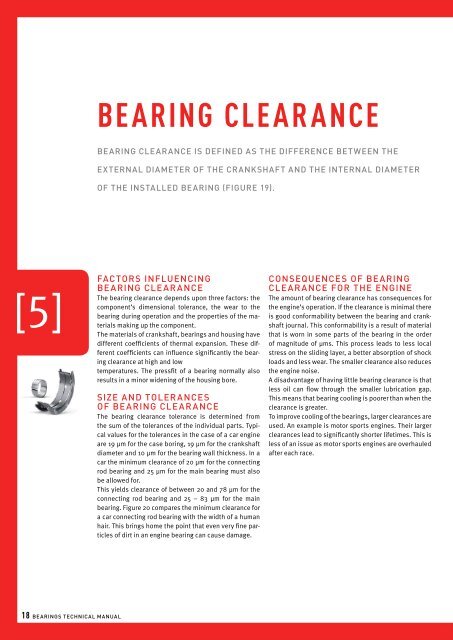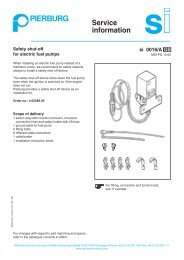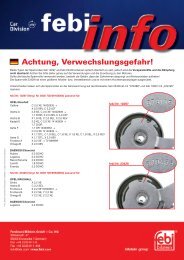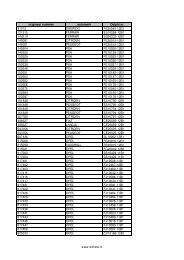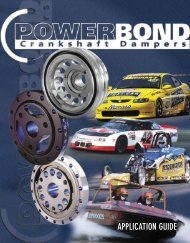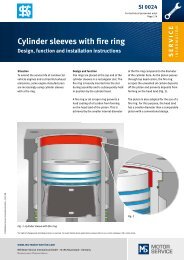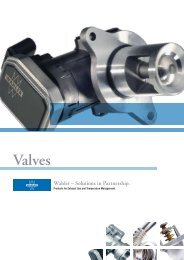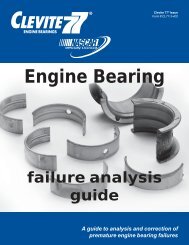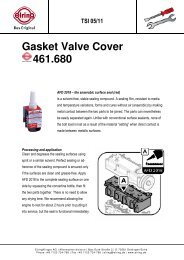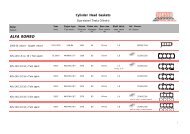EvEry bEaring you nEEd
EvEry bEaring you nEEd
EvEry bEaring you nEEd
You also want an ePaper? Increase the reach of your titles
YUMPU automatically turns print PDFs into web optimized ePapers that Google loves.
[fig.19]<br />
Bearing clearance<br />
Bearing clearance is defined as the difference between the<br />
external diameter of the crankshaft and the internal diameter<br />
of the installed bearing (Figure 19).<br />
d w<br />
C<br />
d i<br />
W<br />
D i + ∆D<br />
the bearing clearance is the difference between the<br />
inner dia-meter of the bearing assembled into the housing<br />
and the outer diameter of the crankshaft journal.<br />
the diameters of housingbore and crankshaft journal<br />
as well as the wall thickness ofthe bearing have to be<br />
within certain tolerances. these toleran-ces are indicated<br />
on the drawings of these components. the total<br />
of the maximum permitted tolerances results in the<br />
maximum of the bearing clearance. for example, minimum<br />
wall thickness combined with largest housing bore<br />
and smallest crankshaft journal diameter result in the<br />
maximum bearing clearance. maximum wall thickness<br />
combined with smallest housing bore and largest<br />
W<br />
crankshaft journal result in the minimum bearing<br />
clearance. the normal minimum bearing clearance is<br />
20 µm for con rod bearings and 25 µm for main bearings.<br />
CLEARANCE: C = Di + ∆D - 2w - dw<br />
[5]<br />
Factors influencing<br />
bearing clearance<br />
The bearing clearance depends upon three factors: the<br />
component’s dimensional tolerance, the wear to the<br />
bearing during operation and the properties of the materials<br />
making up the component.<br />
The materials of crankshaft, bearings and housing have<br />
different coefficients of thermal expansion. These different<br />
coefficients can influence significantly the bearing<br />
clearance at high and low<br />
temperatures. The pressfit of a bearing normally also<br />
results in a minor widening of the housing bore.<br />
Size and tolerances<br />
of bearing clearance<br />
The bearing clearance tolerance is determined from<br />
the sum of the tolerances of the individual parts. Typical<br />
values for the tolerances in the case of a car engine<br />
are 19 μm for the case boring, 19 μm for the crankshaft<br />
diameter and 10 μm for the bearing wall thickness. In a<br />
car the minimum clearance of 20 μm for the connecting<br />
rod bearing and 25 μm for the main bearing must also<br />
be allowed for.<br />
This yields clearance of between 20 and 78 μm for the<br />
connecting rod bearing and 25 – 83 μm for the main<br />
bearing. Figure 20 compares the minimum clearance for<br />
a car connecting rod bearing with the width of a human<br />
hair. This brings home the point that even very fine particles<br />
of dirt in an engine bearing can cause damage.<br />
Consequences of bearing<br />
clearance for the engine<br />
The amount of bearing clearance has consequences for<br />
the engine’s operation. If the clearance is minimal there<br />
is good conformability between the bearing and crankshaft<br />
journal. This conformability is a result of material<br />
that is worn in some parts of the bearing in the order<br />
of magnitude of μms. This process leads to less local<br />
stress on the sliding layer, a better absorption of shock<br />
loads and less wear. The smaller clearance also reduces<br />
the engine noise.<br />
A disadvantage of having little bearing clearance is that<br />
less oil can flow through the smaller lubrication gap.<br />
This means that bearing cooling is poorer than when the<br />
clearance is greater.<br />
To improve cooling of the bearings, larger clearances are<br />
used. An example is motor sports engines. Their larger<br />
clearances lead to significantly shorter lifetimes. This is<br />
less of an issue as motor sports engines are overhauled<br />
after each race.<br />
The influence of oil temperature on<br />
bearing clearance<br />
If the case and the shaft are made of the same material, components<br />
will expand evenly as the oil temperature rises. In this case<br />
bearing clearance remains unaltered as the oil temperature rises.<br />
However, the situation is different if, for example, the case is<br />
made of aluminium and the shaft of steel (Figure 21). Aluminium<br />
expands more than steel with increasing temperature, so in this<br />
case the clearance will rise as temperature increases. Furthermore,<br />
the pressfit will decrease. This effect can be compensated<br />
by an increased crush height, which has already to be considered<br />
during the development of the engine.<br />
At extremely low temperatures the clearance may even fall to<br />
zero, making it impossible to start the engine.<br />
Bearing clearance<br />
200<br />
[µm]<br />
150<br />
100<br />
50<br />
Engine block made of Aluminium<br />
con rod made of titanium<br />
TOLERANCE: Tol. C = Tol. Di + 2 x Tol. w + Tol. dw<br />
human hair<br />
20 µm<br />
[fig.20]<br />
Comparison between a human hair and the minimum<br />
permitted clearance of a con rod bearing of 20 µm.<br />
[fig.21]<br />
The bearing clearance is constant with rising oil temperature<br />
if housing and crankshaft are made of the same<br />
material. The situation changes when different materials<br />
are used. the reason is that different materials have<br />
different thermal expansion coefficients. the diagram<br />
shows two examples for crankshafts made of steel. If<br />
the engine block is made of aluminium, the clearance<br />
-20<br />
0<br />
20<br />
REDUCED LOADING CAPACITY<br />
REDUCED ABSORBING OF IMPACT LOAD<br />
INCREASED DEMAND FOR OIL<br />
50 100 150°C<br />
Bearing temperature<br />
RISK OF JOURNAL SEIZING<br />
increases with rising oil temperatures (continuous<br />
line). If the con rod is made of titanium (e.g. in race<br />
engines), the clearance decreases with rising oil temperature<br />
(broken line).<br />
18 Bearings Technical Manual<br />
19


